Lateral cuts are often decried as poor execution, but they are actually an effective tool for top teams in every division.
December 8, 2015 by Sion "Brummie" Scone in Analysis, Opinion with 41 comments

The article is presented by Five Ultimate; all opinions are those of the author. Please support the brands that make Ultiworld possible and shop at Five Ultimate!
We’ve all heard and read many well-meaning ultimate players giving advice to newbies that essentially boils down to this:
“Lateral cutting is bad.”
I do, of course, understand the sentiment that they are trying to convey – that cutting laterally is “hard” to throw to and more likely to result in turnovers. But the truth is, as always, what is “hard” is related to what you practice or — in this case — don’t practice. Lateral cutting is not inherently a useless strategy and, if done well, can be a very effective cut.
Firstly, let me convince you that elite teams feature lateral cutting heavily. Examples:
Bravo running a reset…
Bravo around throw to lateral cut
…and again…
Bravo inside throw to lateral cut
Lateral cutting can be extremely effective in the endzone. Here’s Ring of Fire using the same method to score…
Bravo inside throw to lateral cut
And this strategy is gender neutral. A lateral cut features in Polar Bears’ endzone offense…
Polar Bears lateral cut for a score
… and Brute Squad’s…
Brute Squad lateral cut for goal
What about downfield movement? Well, for the world’s best Men’s team, Revolver, cutting laterally is a key part of their offense.
Watch Beau Kittredge’s cut here…
Beau continuation cut laterally
Or Beau and Christian Johnson in action here…
The next clip shows Johnson getting open with a lateral cut, throwing to another lateral cut from Joel Schlachet, which leaves Cassidy Rassmussen isolated for a deep shot…
This angle on the same play clearly shows Schlachet cutting laterally across the width of the field…
So if lateral cutting is “bad,” then why are elite teams incorporating these movements into their offenses? Quite simply because changing the disc’s position across the field creates new angles of attack, forcing defenses to make bigger, more frequent adjustments. It is about taking advantage of more of the field’s width.
One extreme — but not wholly uncommon — example of failing to use the width might be a team that jams the disc down the sideline; defenders are not required to reposition and can often ignore players on the far sideline from the disc, knowing that throws all the way across the field width are difficult to complete.
The other extreme is a team that regularly swings the disc around back with their handlers, making use of all the width to open up new angles for cutters. Downfield lateral cutting does the same thing, except it gains yards and often puts cutters in isolation where they can make better use of their more aggressive throws; look back at the Revolver clips and you’ll often see the player with the disc isolated in a huge space.
Throwing To Lateral Cuts
Ok, so cutting laterally can be effective. But the devil is in the details, and this is where the elite teams know precisely how to throw to lateral cuts. Particularly when throwing to the open side lateral cut (i.e. where the downfield defender is most likely to make a play), the angle on the throw is important.
Let’s look at the Polar Bears clip again:
Polar Bears lateral cut for a score
Note the definite outside-in shape on the throw; this helps to put the disc far out in front of the receiver but also to make it slow down and hang, reducing the chances of the disc running out of bounds.
I’ve borrowed some images from the soon-to-be-released ultimate drills and coaching website Flik to help explain. Imagine that the reception area is split into quadrants, as shown below (Fig. 1). Based on the positioning of the mark and downfield defender (D2) A throw into the red quadrant at the bottom left is the most likely to result in a turnover. Cutter B would be forced to turn to their right to catch a pass there, which would also be in the path of defender D2, making it easy for D2 to make a play on the disc.
The least likely throw to result in a turnover, and also the easiest to turn into downfield continuation, is one caught in the green quadrant in the top right.

There are two arrows that indicate possible throws from A to B; one is a flat, straight throw labelled ‘X’. The second is a curving throw labelled ‘Y’. As you can see, ‘X’ travels through the red quadrant, making it a riskier throw than ‘Y’. In order to complete ‘X’, the pass would need to be thrown very accurately and very quickly to hit B perfectly in stride. Even then, B would need to turn to face the throw in order to catch safely.
The best solution is to alter the throw. ‘Y’ represents this option. By throwing a curving pass in front of B, the disc will slow down as it is caught while staying far away from D2. If thrown correctly, it can be caught in the green area easily, making it far easier for B to turn downfield and throw a continuation pass.

Passes caught in the yellow quadrant are more likely to be caught than those thrown into the red, but less likely to lead to continuation than those caught in the green. Because of the position of such a throw, B is forced to turn upfield to attack it (Fig. 2) which means they are now facing away from the attacking endzone, making continuation throws (such as to cutter C) more difficult than if caught in the green zone (Fig. 3) which allows B to catch facing towards continuation options.

Of course, if the throw is put in the right place, then the cutter can easily adjust to maximise the gain. This is why you can often see the cutter change direction once the disc is in the air as they take a path that will lead them into a situation with better continuation — or potentially taking that extra yard for a goal. Check out Schlachet in action for Revolver here:
…and again…
In short, lateral cuts are extremely useful in a variety of circumstances. By understanding how to throw to them more effectively, you’ll be able to incorporate them into your offense. Practice enough, and you might just be able to pull this off: